by DAVID ROLINSON AND SIMON COWARD
Half-Hour Story Writer: Alun Owen; Producer: Stella Richman; Director: Alan Clarke
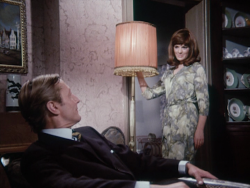 How and why is George’s Room in colour? Anyone coming to George’s Room knowing the rest of director Alan Clarke’s plays for Rediffusion’s Half-Hour Story strand thanks to the BFI’s Alan Clarke at the BBC set might wonder why this is the only one in colour and why it looks so different from the others.1 In comparison with the inventive compositions, fast cutting (vision mixing) and ambitious camerawork of plays like Stella, George’s Room seems highly conventional in its largely static compositions and its alternation between mid-shots, close-ups and wide two-shots: a reviewer at the time said that the play ‘has almost no movement’ and ‘could easily pass as a radio play’, watching characters ‘speaking or listening’.2 In the circumstances this is perhaps unsurprising. Clarke directed this colour version at Wembley Studios, using the same electronic multi-camera set-up as his black and white Half-Hour Story plays. However, George’s Room adapted this set-up in order to use ‘E-cam’, a system designed to make filmed drama in television studios. There were similar attempts to combine television and film technology elsewhere in the television and cinema industries – as we shall see – but Rediffusion were pioneering the integration of film and the electronic multi-camera studio. George’s Room was the main pilot experiment to test ‘E-cam’, which makes it a fascinating moment in British television drama, a stepping stone to possible futures in the use of colour and the convergence between television and cinema. This essay is the most detailed exploration of George’s Room to date. This might not be surprising, given that those studying Clarke could only access an incomplete version,3 until, as the BFI’s Sam Dunn explained, ‘the missing half […] was discovered hiding in the deep recesses of the National Archive’.4 This essay provides information on different stages – from commissioning to overseas sales – but its main focus is on the play as an experiment in colour and electronic film.
How and why is George’s Room in colour? Anyone coming to George’s Room knowing the rest of director Alan Clarke’s plays for Rediffusion’s Half-Hour Story strand thanks to the BFI’s Alan Clarke at the BBC set might wonder why this is the only one in colour and why it looks so different from the others.1 In comparison with the inventive compositions, fast cutting (vision mixing) and ambitious camerawork of plays like Stella, George’s Room seems highly conventional in its largely static compositions and its alternation between mid-shots, close-ups and wide two-shots: a reviewer at the time said that the play ‘has almost no movement’ and ‘could easily pass as a radio play’, watching characters ‘speaking or listening’.2 In the circumstances this is perhaps unsurprising. Clarke directed this colour version at Wembley Studios, using the same electronic multi-camera set-up as his black and white Half-Hour Story plays. However, George’s Room adapted this set-up in order to use ‘E-cam’, a system designed to make filmed drama in television studios. There were similar attempts to combine television and film technology elsewhere in the television and cinema industries – as we shall see – but Rediffusion were pioneering the integration of film and the electronic multi-camera studio. George’s Room was the main pilot experiment to test ‘E-cam’, which makes it a fascinating moment in British television drama, a stepping stone to possible futures in the use of colour and the convergence between television and cinema. This essay is the most detailed exploration of George’s Room to date. This might not be surprising, given that those studying Clarke could only access an incomplete version,3 until, as the BFI’s Sam Dunn explained, ‘the missing half […] was discovered hiding in the deep recesses of the National Archive’.4 This essay provides information on different stages – from commissioning to overseas sales – but its main focus is on the play as an experiment in colour and electronic film.
Background: the play
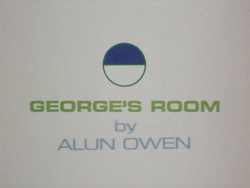 George’s Room is one of several collaborations between writer Alun Owen and director Alan Clarke for Half-Hour Story. They all feature an encounter between a man and a woman: the universal themes at work mean that they are sometimes only identified as ‘Man’ and ‘Woman’. The man in this play (John Neville) arrives in the hope of renting a room from the woman (Geraldine Moffatt): however, we are told that this is ‘not merely a room’, but has come to symbolise the continuing influence of her late husband.
George’s Room is one of several collaborations between writer Alun Owen and director Alan Clarke for Half-Hour Story. They all feature an encounter between a man and a woman: the universal themes at work mean that they are sometimes only identified as ‘Man’ and ‘Woman’. The man in this play (John Neville) arrives in the hope of renting a room from the woman (Geraldine Moffatt): however, we are told that this is ‘not merely a room’, but has come to symbolise the continuing influence of her late husband.
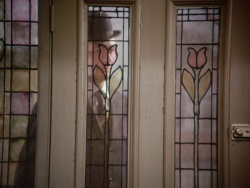
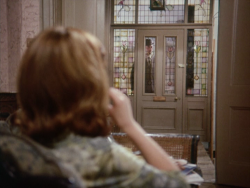 The man’s potential invasion of this space is signposted by the opening shot, the nearest that the play gets to dynamic movement: as the man rings the doorbell we see his shape through the door, which is attributed to her perspective as a reverse zoom finds her sitting watching, clearly thinking about whether or not to answer. As their conversation develops we seem to be back in the territory of Shelter as a man tries to draw out the story of an unhappy wife: this device is characteristic of Owen, who later said that he was ‘much more interested in women than in men and you’d be surprised what they tell me’.5
The man’s potential invasion of this space is signposted by the opening shot, the nearest that the play gets to dynamic movement: as the man rings the doorbell we see his shape through the door, which is attributed to her perspective as a reverse zoom finds her sitting watching, clearly thinking about whether or not to answer. As their conversation develops we seem to be back in the territory of Shelter as a man tries to draw out the story of an unhappy wife: this device is characteristic of Owen, who later said that he was ‘much more interested in women than in men and you’d be surprised what they tell me’.5
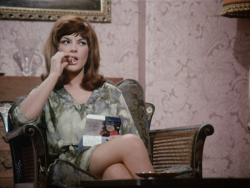 Moffatt’s character in Stella used her wit and articulacy to reject her boyfriend’s attempt to control her perspective, but her character in George’s Room struggles to rebuild her self-esteem after a controlling relationship – as one reviewer put it, ‘the dead George has reduced his widow almost to nonentity’6 – and Moffatt’s skilful performances evoke these differences. Where Stella eviscerated a man for trying to make his point of view dominant, this woman believes that ‘Ladies are more passive’ and remarks: ‘Oh, men! You’re always saying things’. Seeing the play in the context of the gender concerns across Owen’s work in the period makes some sense of what otherwise seem to be crass stage directions in the published theatre version: ‘She is no more than thirty and very pretty, but not overly bright.’7 George is an absent presence throughout: he ‘didn’t approve of femininity’ and moved into the spare room, having lost interest in sex, and she came to fear this room when called in by him on Fridays to collect her housekeeping money. Neville’s character tries to draw her out but is another patriarchal invader, admiring her because ‘you were made for men’ – as Lisa Kerrigan puts it, this somehow feels less ‘unsavoury’ due to Neville’s performance8 – while noting that ‘you disturb’, and calling himself ‘Adam’s heir’ as if a Fall from innocence awaits. He promises to let her ‘fidget’ in George’s room – that always-present but never-visible patriarchal space – in order to control her fears, but is this a way to escape or does it now seem problematic? As Lisa Kerrigan observes in the blu-ray book, he is ‘the disruptor, pushing liberation where it might not be entirely welcome’, potentially ‘angel’ or ‘devil’ in a play that is ‘playful while exposing the darker underside to relationships’.9
Moffatt’s character in Stella used her wit and articulacy to reject her boyfriend’s attempt to control her perspective, but her character in George’s Room struggles to rebuild her self-esteem after a controlling relationship – as one reviewer put it, ‘the dead George has reduced his widow almost to nonentity’6 – and Moffatt’s skilful performances evoke these differences. Where Stella eviscerated a man for trying to make his point of view dominant, this woman believes that ‘Ladies are more passive’ and remarks: ‘Oh, men! You’re always saying things’. Seeing the play in the context of the gender concerns across Owen’s work in the period makes some sense of what otherwise seem to be crass stage directions in the published theatre version: ‘She is no more than thirty and very pretty, but not overly bright.’7 George is an absent presence throughout: he ‘didn’t approve of femininity’ and moved into the spare room, having lost interest in sex, and she came to fear this room when called in by him on Fridays to collect her housekeeping money. Neville’s character tries to draw her out but is another patriarchal invader, admiring her because ‘you were made for men’ – as Lisa Kerrigan puts it, this somehow feels less ‘unsavoury’ due to Neville’s performance8 – while noting that ‘you disturb’, and calling himself ‘Adam’s heir’ as if a Fall from innocence awaits. He promises to let her ‘fidget’ in George’s room – that always-present but never-visible patriarchal space – in order to control her fears, but is this a way to escape or does it now seem problematic? As Lisa Kerrigan observes in the blu-ray book, he is ‘the disruptor, pushing liberation where it might not be entirely welcome’, potentially ‘angel’ or ‘devil’ in a play that is ‘playful while exposing the darker underside to relationships’.9
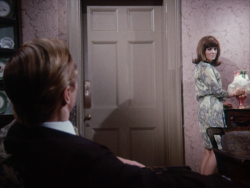
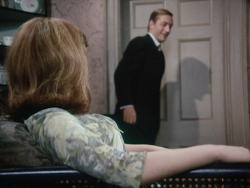
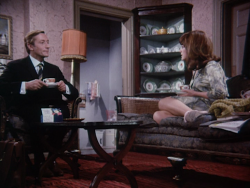
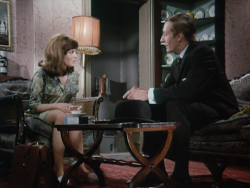 Clarke often found a style with which to reinforce the to-and-fro of Owen’s couples. In Stella there was fast vision mixing and the use of unsettling angles; in George’s Room these are almost absent (though the characters’ opening conversation in the hallway does move relatively quickly between low-angle close-ups, which was one of his signatures). Instead, as in Thief, meaning is supported by shifts in blocking, such as the moment in Act 2 in which the woman is foregrounded with the man in the background, which reverses the treatment of a moment in Act 1.
Clarke often found a style with which to reinforce the to-and-fro of Owen’s couples. In Stella there was fast vision mixing and the use of unsettling angles; in George’s Room these are almost absent (though the characters’ opening conversation in the hallway does move relatively quickly between low-angle close-ups, which was one of his signatures). Instead, as in Thief, meaning is supported by shifts in blocking, such as the moment in Act 2 in which the woman is foregrounded with the man in the background, which reverses the treatment of a moment in Act 1.
We can explain why George’s Room ended up in colour – in our account of the ‘E-cam’ experiment – but we have yet to find in the documentation a definitive reason why this particular play was selected ahead of any others. We cannot rule out coincidence: as we shall see, it was in the studio at a time when the pilot experiments were being made. However, it was clearly a piece by a proven pairing: the highly-acclaimed big-name writer Owen and the burgeoning talent of Clarke, one of the ‘young team’ that producer Stella Richman named in publicity as having ‘brought lots of energy and invention to the series’.10 The fact that the play only required two actors in, effectively, one room may also have helped, but Clarke had already shown that this was no barrier to a more ambitious visual approach than is evidenced in the colour version of George’s Room.
Commissioning and rehearsal
Owen was commissioned in May 1967 to deliver a first draft of this as-yet-untitled script by 26 June, followed by a ten-day deadline for acceptance and a ten-day deadline for a final script.11 According to initial contracts, rehearsals for George’s Room took place on consecutive days between 18-22 July, with a day scheduled for rehearsals and (between 5:00-5:30 p.m.) ‘promotion filming’ on 24 July.12 (Most of Clarke’s Rediffusion pieces have a day allocated for ‘promotion filming’, a phrase which does raise the tantalising prospect of specially-shot trails or the advanced shooting of scenes for trails – which would be of particular interest for those productions which do not survive in the archives – but there is no surviving evidence of this. It is more likely that the phrase refers to stills photography.)13 The rehearsal pattern for George’s Room is consistent with other Clarke pieces of the time: The Gentleman Caller rehearsed in an unspecified venue between 29 May-6 June 1967 (excluding 4 June) ahead of 7 June recording; Got Yourself Sorted Out At All? (an episode of A Man of Our Times) rehearsed on unspecified dates between 2 November and 2 December in Clapham Junction BAT 2036 alongside location videotape recording on 27-28 November and ahead of studio recording on 5 December, and Goodnight Albert rehearsed between 27-30 December 1967 and 1-4 January 1968 in Room D Television House ahead of studio recording on 5 January.14
Studio sessions
In the documentary accompanying the Clarke set, Geraldine Moffatt recalls having to shoot George’s Room twice:
[Alan Clarke] made it twice. It was first of all made in black and white and in fact I think there were over 200 cuts […] in the black and white version. And I remember that he was quite sad because Rediffusion wiped the black and white version within a few days of doing it, and they retained […] the version in colour which we filmed or recorded the next day. And the colour version has less cuts in it than the black and white version.15
The production documents provide further information.16 The two versions were shot in Wembley’s Studio 5A: on Tuesday 25 July and Wednesday 26 July respectively. Moffatt’s memory may indicate that plans changed from those in the documents, but it appears that the Tuesday session was planned for the colour episode, given that the recording session is marked ‘PHOT/REC’ while Wednesday’s is marked ‘VTR’ and the scheduled working day is noticeably long. Between 8:00 a.m. and 10:00 a.m. there was a combined period of setting, lighting, make-up and line-up. There were two camera rehearsal periods between 10:00 a.m. and 1:00 p.m. and between 2:00 and 6:30 p.m (punctuated by the lunch break between 1:00 and 2:00 p.m.). After a dinner break (6:30 to 7.30 p.m.), there was the usual make-up and line-up session between 7:30 and 8:30 p.m. The play was simultaneously recorded and photographed [filmed] between 8:30 and 9:30 p.m. On Wednesday, the black and white version was recorded. After setting and lighting (11:30 a.m. – 12:30 p.m.) and a lunch break (12:30 – 1:30 p.m.), a camera rehearsal took place between 1:30 and 4:00 p.m. followed by make-up and line-up (4:00 – 5:00 p.m.). The play was then recorded between 5:00 and 5:45 p.m. before the sets were struck between 5:45 and 6:30 p.m. The same crew appears to have worked on both versions, including Derek Cochrane and Crew 2 on cameras and Brian Penny on sound, though it would be useful to be able to clarify the joint credit for Bill Lee and Tony Hepher for lighting, given the demands of lighting for ‘E-cam’ which this essay will now outline.17
‘E-cam’
Rediffusion Television’s in-house magazine Fusion18 explained that
[E-cam] stands for electronic cameras, a system of using film cameras in the same way as television cameras but recording the end product on film instead of tape. While other organisations have worked on the system with single cameras, Rediffusion Television was the first to make a film in TV studios using an integrated, multi-camera system.19
This text introduces an article in which the engineer-in-charge of ‘E-cam ops.’, Mike Metcalfe, wrote an account of the ‘E-cam’ process. George’s Room was one of the ‘pilot experiments’. The other was ‘scenes from’ The Small Rebellion of Jess Calvert, though sadly none of that Summer Playhouse production is known to exist and the fate of the ‘E-cam’ footage is presently unclear.20 According to Metcalfe, E-cam was motivated by ‘a desire to produce high quality film programmes by television methods’.21 Of course many British television dramas had been made on film – for instance The Adventures of Robin Hood (1955-59) – and there would be many more made entirely on film or in a ‘pie-bald’ mixture of videotaped studio interiors and filmed exteriors (or filmed interiors using former cinematic sites such as Ealing Studios). Therefore, the key distinction here is ‘by television methods’, which for the majority of productions involved recording on video in the electronic multi-camera studio. Some academics, in particular Deborah Jaramillo, have recently critiqued the tendency in academic and broadsheet writing about television to privilege the ‘cinematic’, to the extent that ‘cinematic’ has become a problematic superlative which perpetuates an ‘antiquated […] hierarchy’ rather than engaging television’s specific characteristics and strengths.22 The multi-camera studio would be the home for a great many radical and innovative dramas over the decades, often building on the advances of experimental theatre at a time when ‘theatricality’ was not a pejorative term but a marker of one of television’s strengths (though admittedly some programme makers were very keen to get away from the studio and onto film or into cinema).
These issues make ‘E-cam’ an even more fascinating moment in British television technology. According to Metcalfe, this ‘long-standing dream’ of combining film and television methods would ‘reduce production costs’ and ‘overcome the serious technical problems associated with the international exchange of programmes for television’. In particular, there was already the need to convert programmes so that they could be played in countries with different line standards, and these issues would be multiplied with the introduction of differing colour standards. Making drama on film would bypass such problems given the telecine equipment in television studios: ‘film has become the universal currency of programme exchange’.23 During this period, for companies in the UK hoping to interest international buyers in their wares, there were two primary options: originate the programme on 35mm film with the intention of selling it to one of the American networks, or produce the programme on videotape and provide any purchasers with a set of telerecordings on 16mm or 35mm film. By 1967, there was a third option in occasional operation – that of recording the programme on tape in NTSC format, which usually meant performing the production twice. While this system was used for some variety and light entertainment shows such as Rediffusion’s Hippodrome and ATV’s Piccadilly Palace this was rarely considered for drama as the de facto standard for American drama series – excluding daily serials, soaps – was 35mm film in any case.
Metcalfe’s piece reminds us that television dramas are tied with technological histories as well as questions of aesthetics and identity. For example, John Caughie responded to a TV Times piece celebrating the ‘dollar-earning capacity’ of The Adventures of Robin Hood (given its American success) by noting that the BBC had been ‘slow to commit itself to the high-cost, high-risk strategy of shooting series on film for the uncertainties of foreign taste’ but by 1961 was ‘recording its Maigret series simultaneously on Ampex tape, 16mm and 35mm film, using the cheaper techniques of drama’ to try to appeal to the international market.24 Caughie notes that films of events had sold abroad in the past but
now what had been conceived as purely national and cultural production [drama] had the potential to enter the international market as a commodity. Much of the subsequent development of British television drama – the shift from single play to art film, the rise of the classic serial […] the shift to film technology and aesthetics – can be dated from the moment at which drama becomes simultaneously expensive, recordable, and marketable.25
The American success of The Adventures of Robin Hood showed it to be a saleable commodity in more senses than one. Making drama entirely on film was more time-consuming and expensive than working in multi-camera studios, whose economies of scale meant a large volume and variety of drama, and Caughie’s study later demonstrates that filmed drama had positive and negative impacts on that volume and variety and the very idea of television drama as ‘national and cultural production’.
Metcalfe observes that there had already been attempts at ‘coupling a television camera to a film camera in order to monitor the scene remotely and to facilitate the control of several cameras’.26 This latest attempt at ‘Electronicam’ used an Arriflex 35 mm film camera, ‘developed by Arnold & Richter of Munich’ from the ‘photo-recording system’ that they devised in 1955 (a collaboration with Dumont in New York which Metcalfe discusses). Rediffusion’s engineers collaborated with Fernseh to produce a ‘television channel’.27 Metcalfe’s article includes several photographs of the technology in use, including an Arri Electronic Cam unit supplied by Rank Audio Visual Limited.28
Metcalfe explains the process in his article, and although we will not quote this description at length because it is an intricate technical account, we can pick out a few features which help us to understand how George’s Room will have been produced. A ‘specially designed reflex shutter’, ‘reflecting segments’, ‘correcting lenses’, a ‘Plumbicon camera attached to the side of the film camera’ and a ‘monitor viewfinder mounted at the back of the camera’ that is used ‘in exactly the same way as a television camera’29 all mean that:
The cameraman […] has normal control of zoom, focus and framing etc. The television picture is also available to monitors in the various control rooms.
The method of operation follows closely that of a standard television studio production. Pictures from all cameras are permanently available to the director whether the film is running or not. Rehearsal takes place in the usual manner and film is only exposed for the actual transmission/take. […] The actual transmission/take is accomplished by pressing the appropriate button on the simple vision mixer panel which starts the film camera and switches its television picture to ‘transmission’30
This description tallies with the ‘e. cam procedure’ which was provided at the start of Clarke’s camera script for George’s Room, which includes notes to wait for the red light to come on (and ‘check cameras on remotes’), then for the blue light (for sound recording), then to mark the first camera with the clapper.31 The lighting director could maintain ‘the close exposure tolerances required for successful colour filming’ thanks to remote operation of each camera’s lens iris and monitoring facilities.32 Sound was recorded as usual – ‘on sprocketed magnetic tape running in synchronisation with the film cameras’ – but each camera had its own ‘cue tone’ to help ‘the later assembly of the processed film’.33
The director needed to plan carefully as always but with some different considerations. For instance, the magazine on each camera held 1,000 feet of film (as Metcalfe points out, 10 minutes of running time), so the director needed to pre-plan sequences to make the best use of them; to help, the control desk contained ‘footage counters’ estimating the amount of film to be used by each camera in a forthcoming take.34
This process might help to explain why Clarke in George’s Room avoids the kind of fast cutting (that is, vision mixing) that is a characteristic of much of his early work at Rediffusion. As Metcalfe explains, ‘Cutting from one camera to another is achieved by pressing the appropriate buttons, and after a delay of approximately 1/3 second, to enable the camera motor to attain speed, the vision is automatically switched and the film exposed.’35 However, Metcalfe also demonstrates that the need for fast cutting had been anticipated: ‘For fast cutting sequences an extra button is provided enabling the selected cameras to stay running while cutting between them, thus obviating the running-up delay. This method, of course, is wasteful of film and should only be used for short periods. As it is not possible to fade or mix between the film cameras, the vision mixer is a simple ‘cut only’ device.’36
Colour
Colour would exacerbate the technical problems in international sales which Metcalfe discussed above, because, as he noted, colour systems also varied around the world. However, colour also posed specific challenges in the British context, with the slow and sporadic rollout of colour television and issues raised by its use. The timing of George’s Room is vital, coming as it did in 1967. BBC 2 switched to a full programme of colour in December 1967 – one of its flagships being a colour production of William Makepeace Thackeray’s Vanity Fair which echoed the use of the same novel, adapted via the play Becky Sharp, as the first feature film to use the new full-colour ‘three-strip’ Technicolor process in 1935. But while that particular book may have been selected for its colour potential, the television adaptation of ‘the classic novel’ had been a staple of the BBC’s second channel since its inception, so the advent of colour was hardly pushing the channel to break new dramatic ground. BBC 1 and the ITV companies in London, the south-east, the midlands and the north followed suit in November 1969, with the majority of the remaining independent companies converting by 1971.37 It is hard to see any significant change in the types of drama carried by BBC 1 and ITV over this period. Both sides benefited from colour material already produced: with BBC 1 being able air colour programmes previously shown on BBC 2, and ITV having the opportunity to give a first UK colour broadcast to some of the British film series which had previously only been shown in black and white. Fewer than 2% of households had colour television licenses by April 1970, so few can have appreciated these early opportunities.
Recent studies of the arrival of colour at the BBC include Leah Panos’s 2015 study of ‘the diverse range of chromatic aesthetics developed during the early colour period’ through analysis of three pieces directed by Rudolph Cartier between 1967 and 1969; these show how colour ‘instigated various changes within the BBC at material, practical and conceptual levels’, from studios to marketing and value.38
In 2016, Helen Wheatley devoted a chapter of her book Spectacular Television to these early years of colour television at the BBC and valuably places programmes like Vanity Fair, and the necessarily slow-take up by audiences mentioned above, in interweaving technological, institutional, cultural and aesthetic contexts. Wheatley discusses different genres including variety and sport, but picks up on tendencies of ‘chromophobia’ in television (comparable with those in Film Studies) to note the view that:
whereas, on the one hand, colour had the potential to add new layers of meaning to a production of television fiction and could, therefore, be used in expressive, and eloquent, ways, on the other hand, it might also be seen as producing a more superficial ‘prettifying’ of the television drama, offering an increased sense of spectacle and an attention to the surface of the image rather than producing greater depth of meaning.39
This potential for ‘chromophobia’ has an equivalent history in British cinema in which, as Sarah Street noted, the ‘cinema of “quality” persisted as an aesthetic style associated with black and white’ and, when colour was used, there was a preference for ‘“cautious neutralised” colour that posed little threat to clear narrative comprehension’.40 Therefore, part of the reason for the critical disdain that for a while followed Michael Powell and Emeric Pressburger was the use of vivid colour in their films: the man most responsible for delivering this, director of photography Jack Cardiff, himself noted that there was a danger of being seen as ‘vulgar’ or ‘pretentious’ by using colour – the stock-in-trade of less critically-accepted horror, melodrama or fantasy films – and yet now Powell, Pressburger and Cardiff films such as Black Narcissus are acclaimed for the ways in which we are, as Martin Scorsese put it, ‘bathed in colour’.41
Wheatley demonstrates that those on the BBC’s ‘Colour Familiarisation Course’ were also warned about colour that looks ‘gaudy’,42 and how the BBC sought to avoid the kind of colours used by the Americans43 and to achieve ‘realist colour’ rather than ‘spectacular colour’.44 At Rediffusion, the muted colours in George’s Room place this production in the ‘realist colour’ camp – discreetly contributing to mise-en-scène to add to our understanding of place and therefore, in the logic of the woman’s situation, character – though as always we are in the hands of the available print. (As Wheatley reminds us, over and above problems for Film Studies in the possibility that film prints in cinemas may not match their makers’ intentions, in television there are the vagaries of signals and each viewer’s individual television’s settings.) At this stage, the very presence of colour – for those few able to afford colour sets or those who attended the BBC’s big public events held to promote colour television – is the spectacle.45
Add-a-Vision
George’s Room may now seem like an anomaly, not only in terms of Clarke’s career (Half-Hour Story soon ended, Rediffusion soon gave way to Thames Television and Clarke soon moved to the BBC notwithstanding a few sporadic ITV productions) but also in terms of the ‘E-cam’ experiment. Intriguingly, however, variations on the concept persisted for several years and in different ways.
Developments around ‘E-cam’ in this period were not merely an attempt to bring the language of film production into the video studio: instead, film studios sought to gain from technological convergence by using electronic aids. Associated British Productions released a glossy brochure describing themselves as ‘the first major motion picture studios in the world to install Add-a-Vision’, a system manufactured by Prowest Electronics.46 This ‘unique new equipment’ provided ‘the marrying of television techniques to motion picture production, by the addition of a T.V. camera to a B.N.C. Mitchell Camera’.47
The programmes on which the system was used include a play filmed for ATV’s Love Story strand at their Elstree studios, but the brochure understandably focuses on an Associated British production, The Avengers.48 The brochure explains that using the system, with a B.N.C. Mitchell Camera, generates benefits including: savings in production time by removing the need for a ‘post mortem’ after each take, reducing time needed for camera line-up and rehearsals, providing ‘instant rushes’ via a video tape recorder, providing zoom lenses, reducing the number of people on the set (who could consult monitors) and helping camera operators and lighting cameramen to maintain focus and exposure. The brochure quotes several people working on The Avengers, including director Don Sharp, who felt ‘very great enthusiasm’ for a system which saved 10% of his time per episode and ‘improved the performance of all the artistes’: he stated that ‘I shall feel lost, deprived of a great aid, when I go back to conventional shooting.’49
The ‘Add-a-Vision’ brochure notes that Elstree had anticipated the use of ‘electronic aids’ and a movement to ‘multi-camera usage and new lighting techniques’, and so installed its new stages with ‘a television type lighting grid and vision and sound control rooms.’50 In 1965, Elstree technicians investigated ‘the only existing system in operation’, in Munich (Munich is important here as well as in the Rediffusion story, as Arnold & Richter of Munich collaborated on the 1955 New York tests mentioned by Metcalfe), and developed their own system. The authors anticipated the simultaneous use of ‘up to four Add-a-Vision cameras’ as in a multi-camera television studio and the expansion of its video facilities (V.T.R. machines, such as those used on George’s Room) and colour telecine. The brochure speculated on future developments, including ‘remote control of zoom, focus and iris’ and ‘a location camera vehicle’. Around the same time, in March 1968, ‘Add-a-Vision’ was profiled in The Stage and Television Today.51 Here, John Weston pondered on how television and film production techniques ‘have developed in totally different ways in spite of the fact that the end results, in the case of a drama at least, may be very similar indeed’.52 Though largely processing material from the Elstree brochure, Weston quotes Maurice Gorham’s belief – in the 1949 book Television, Medium of the Future – that ‘Television production is a more flexible method than film production’; for Weston, the system predicted by Gorham had at last arrived and provided ‘an important step forward’ for British television.53
As late as February 1970 ‘Add-a-Vision’ and ‘E-cam’ were discussed by Peter Graham Scott at a Royal Television Society meeting on ‘film versus television techniques’.54 Having worked at the BBC, Rediffusion and in feature films, Graham Scott had recently set up Challenge Productions Ltd. in order to ‘pioneer new and economical production methods’. His emphasis was to be on ‘productivity’, but again noting the benefits for feature films as well as for television.
Broadcast
George’s Room was broadcast at 9.00pm on 30 August 1967 in most ITV regions – except Scottish, TWW and Teledu Cymru55 – unlike the widespread regional variations which affected some of Clarke’s earlier plays.56 It replaced another scheduled play – Quick on the Takeover – so late that the latter play was billed in all listings magazines and all of the newspaper listings that we have consulted to date. However, for the purposes of this article, we will move on to what happened next…
Overseas sales
Given Metcalfe’s statement that ‘the E-cam system can be a vital link in the chain of international programme exchange’57, it is worth looking at overseas sales: did E-cam have an effect here? The production files are not conclusive, though George’s Room was one of the plays that interested overseas buyers. Global Television Services handled overseas sales for Rediffusion, and the files show them making contact regarding a number of Half-Hour Story plays. Much more research is required on the history of British television’s overseas sales – and it is anyway too large a topic for this essay – but it would be particularly interesting to trace the overseas sales of different regional ITV companies. (By comparison, the history of the BBC’s overseas sales has been more widely researched, in particular those programmes that are missing-believed-wiped, in particular when those programmes are Doctor Who.) However, we can make a start on Half-Hour Story.
The Sales Brochure for Half-Hour Story’s first series lists eighteen available plays, including George’s Room.58 The text for George’s Room reads as follows:
Geraldine Moffatt and John Neville star in an intriguing story about a landlady who has a room to let. When a gentleman calls to inquire about the room, it transpires that the room belonged to her late husband, and that whoever is to be the new occupant is going to have to preserve it in its original state, in memory of the dead husband. The man insists on changing the furniture around, thereby breaking the spell.
The press in London were particularly enthusiastic about this episode, and Robert Ottoway of the Daily Sketch said, “This probing first meeting between a would-be lodger and his bashful landlady has all the virtues of concentration we associated with master short-story writers”. Mr. Ottoway had this to say about Half-Hour Story: “This series has turned into the most reliable entertainment of the summer.”59
Various production files contain some of the paper trail for global sales of Half-Hour Story plays. Some of these files generate potential sources of new research into Clarke and Rediffusion’s international reception – for instance the Dutch press made contact for promotional material for the broadcast of The Gentleman Caller – and possibly even sources of inquiry regarding those plays which are still missing believed wiped. For now, we can briefly trace the international appeal of George’s Room. In November 1967, Global noted that Sweden were interested in six episodes, naming George’s Room alongside Dead Certainty, Necklace and No Sale at Newhaven.60 By January 1968, Owen had agreed to the authorisation of a broadcast of George’s Room in Holland and Belgium;61 Holland were similarly interested in Owen and Clarke’s Shelter after stated interest in Gone and Never Called Me Mother.62 By March 1968, agreement had been reached with agents regarding the broadcast in Norway of George’s Room,63 and in Eire of George’s Room as well as Hawks and Doves.64 Nigeria and Portugal expressed an interest in George’s Room, as was discussed in February 1969 and June 1969 respectively.65 By the end of 1969 there was interest from Zambia and Malaysia.66 In all cases, Rediffusion contacted writers in order to exercise options in the contracts, which stipulated rates for different nations and types of broadcast.67 Rediffusion had the right ‘to acquire options on overseas rights’ within a certain time period, and the option was initially exercisable within twelve months.68 The use of music could sometimes add complications, but George’s Room is noted as containing only the series’ theme music.69
Further research is needed to discover the impact of the colour version on overseas sales of George’s Room or, indeed, whether the colour and black and white versions were both made available. Moffatt’s memory (quoted above) is that the black and white recording was very quickly wiped, though given the widespread practice of wiping television recordings after telerecordings or film prints had been made of them, this statement does not preclude the continued existence of a print for overseas sales. The surviving documentation is unclear: a document sent to Global Television has a typed note added, stating that ‘A 16 mm COLOUR PRINT OF THIS EPISODE IS ALSO AVAILABLE’,70 which indicates that a black and white version (print or telerecording) was the primary version available (unless a black and white copy was instead struck from the colour film, which would be counter-intuitive given that a black and white programme was made). It is the case that some national broadcasters continued to depend upon black and white programmes for many years, even at a time when British broadcasters were wiping them as colour came to dominate. It was possible to produce black and white telerecordings of colour productions and for much of the 1970s a significant proportion of their sales would be in that format. A result is that some colour programmes were wiped and now only survive as black and white sales copies.
Some Half-Hour Story plays had an afterlife: London Weekend Television repeated (or, from the perspective of young broadcaster LWT, showed for the first time) a few in 1971. These appear to have included several of Clarke’s: Shelter, Which of These Two Ladies is He Married To?, Nothing’s Ever Over… and George’s Room.71 George’s Room was repeated on 8 February 1971: was this a colour version? Listings in TV Times and newspapers list all the repeats as being in black and white, but this need not be conclusive. The first few weeks of the repeat run coincided with the 1970/71 colour strike, but its end was reported the day before George’s Room was repeated, although colour production was not due to resume until the following week. This strike may still have been an issue if the play had needed to be transferred to tape by LWT and this had already been carried out. It seems likely that colour broadcasting had resumed by the time George’s Room was shown. We are still investigating the repeat broadcast and will update this post if we learn any more. Meanwhile, at time of writing, only the colour version of George’s Room is known to exist.
Conclusion
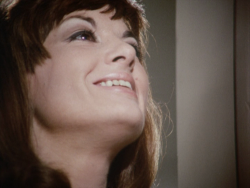 In another example of its afterlife, George’s Room was shown at the eighth International Television Festival at Monte Carlo in 1968 – Geraldine Moffatt attended, giving interviews at the Festival Club at the Hotel de Paris.72 Owen’s play script was published by Samuel French in 1968.73 The surviving colour television version ends before this published version, which ends with both characters walking into George’s room. This might not indicate a difference between the colour and black and white version because, as with the similar publication of Shelter (another Owen-Clarke production), this published version was in the form of a theatre production. This gave stage directions and a diagram of the set layout for the stage, not for the television production. However, it is clear from Moffatt’s interview on the BFI collection that there were marked differences between the colour and black and white version. Without seeing the two of these together, or as yet being able to compare different camera scripts, it is difficult to know the extent to which ‘E-cam’ specifically altered Clarke’s approach. It differs from his other Half-Hour Story pieces, but he was always keen to explore different styles to find the suitable form for the content and this version of George’s Room is another example of the quality of Clarke’s early work at Rediffusion. In December 1967, Owen and Clarke won ‘Golden Star’ awards from Rediffusion for their contributions to the station’s output, although it was Owen’s citation that picked out George’s Room whereas Clarke’s named the now-lost Which of These Two Ladies Is He Married To? and ‘other plays in the same series’.74
In another example of its afterlife, George’s Room was shown at the eighth International Television Festival at Monte Carlo in 1968 – Geraldine Moffatt attended, giving interviews at the Festival Club at the Hotel de Paris.72 Owen’s play script was published by Samuel French in 1968.73 The surviving colour television version ends before this published version, which ends with both characters walking into George’s room. This might not indicate a difference between the colour and black and white version because, as with the similar publication of Shelter (another Owen-Clarke production), this published version was in the form of a theatre production. This gave stage directions and a diagram of the set layout for the stage, not for the television production. However, it is clear from Moffatt’s interview on the BFI collection that there were marked differences between the colour and black and white version. Without seeing the two of these together, or as yet being able to compare different camera scripts, it is difficult to know the extent to which ‘E-cam’ specifically altered Clarke’s approach. It differs from his other Half-Hour Story pieces, but he was always keen to explore different styles to find the suitable form for the content and this version of George’s Room is another example of the quality of Clarke’s early work at Rediffusion. In December 1967, Owen and Clarke won ‘Golden Star’ awards from Rediffusion for their contributions to the station’s output, although it was Owen’s citation that picked out George’s Room whereas Clarke’s named the now-lost Which of These Two Ladies Is He Married To? and ‘other plays in the same series’.74
Thanks to the British Film Institute.
Simon Coward is a member of Kaleidoscope: anyone with any interest in archive television should visit Kaleidoscope for more information.
This research is ongoing and the authors welcome any corrections or further information.
Originally posted: 31 July 2016.
Updates:
1 August 2016: minor typographical corrections.
George’s Room appears on both DVD and blu-ray versions, while the others appear only on the blu-ray. ↩
Henry Raynor, ‘Radio play for television’, The Times, 31 August 1967, p. 5. ↩
Half of the play, joined with the published script, form the basis of the analysis in Dave Rolinson, Alan Clarke (Manchester: Manchester University Press, 2005. ↩
Sam Dunn, quoted in James Oliver, ‘Sam Dunn, producer of Dissent and Disruption: Alan Clarke at the BBC’, available at Moviemail here. ↩
Alun Owen, quoted in Alix Coleman, ‘Inside Television: The things women tell Alun Owen’, TV Times London region, 6 December 1973. ↩
Raynor. ↩
Alun Owen, George’s Room (London: Samuel French, 1968). ↩
Lisa Kerrigan, ‘George’s Room’, Dissent & Disruption: Alan Clarke at the BBC, book accompanying blu-ray release (London: British Film Institute, 2016), p. 24. ↩
Ibid. ↩
Half-Hour Story sales brochure, Rediffusion, accessed from Simon Coward’s own collection, p. 2. ↩
Such commissioning documents do not necessarily prove that a script was not already underway or that the play delivered did not deviate from the version that was commissioned, especially given that the title and contents are not specified on this document – Script Requisition Form, signed 30 May 1967, George’s Room production folder, accessed in British Film Institute library. ↩
The files do not confirm whether these rehearsal dates were strictly adhered to or whether fewer or different dates were ultimately used. ↩
See, for instance, the promotional images for Shelter and The Gentleman Caller in the blu-ray booklet which do not take place on the studio set. ↩
The Gentleman Caller and Goodnight Albert schedules accessed in British Film Institute library. A Man of Our Times production schedule accessed from independent source. ↩
Geraldine Moffatt, interviewed in Out of His Own Light, extra on Alan Clarke at the BBC (British Film Institute, 2016). ↩
George’s Room, Associated Rediffusion file ART/534 folder 1, viewed at the British Film Institute library in 2016. ↩
There may be two contracts for overseas sales given that one has “FILM” written at the top in pen. “30th Aug. ‘67” is written as the transmission date; the capital A matches that in signatures by Clarke elsewhere in the production files. ↩
Fusion was Rediffusion Television’s (and before that Associated-Rediffusion’s) house magazine. It was published, usually quarterly, from 1958 to 1967. ↩
‘e-cam’, Fusion Number 48/49 double issue, Christmas 1967, p. 43. ↩
Summer Playhouse: ‘The Small Rebellion of Jess Calvert’, tx. ITV, 7 August 1967. Wr. Alec Travis, dr. Peter Moffatt. It is unclear from the wording whether this production was in colour or just on film – E-cam could be used for colour or black and white – and the piece does not state that the scenes were shown in the Summer Playhouse broadcast. It is possible that the play happened to be in the studio at the right time – we are only aware of one recording date for the broadcast version – 9 July 1967 – and that the sets were re-used. ↩
Metcalfe, ‘e-cam’, p. 43. ↩
Deborah Jaramillo, ‘Rescuing television from the “cinematic”: The perils of dismissing television style’, in Jason Jacobs and Steven Peacock (editors), Television Aesthetics and Style (London: Routledge), pp. 67-75. For a recent reply more tied to British dramas such as Happy Valley, see Helen Piper, ‘Television drama and the problem of television aesthetics: home, nation, universe’, Screen, Volume 57, Number 2, 2016, pp. 163-183. ↩
Metcalfe, ‘e-cam’, p. 43. ↩
John Caughie, Television Drama: Realism, Modernism and British Culture (Oxford: Oxford University Press, 2000, p. 55. ↩
Ibid, pp. 54-55. ↩
Metcalfe, ‘e-cam’, p. 44. ↩
This channel ‘using a Plumbicon picture tube and embodying the latest circuitry’. ↩
Ibid. ↩
Ibid., p. 44. ↩
Ibid., pp. 44-45. ↩
George’s Room camera script, p. I – 1. Accessed at the British Film Institute library. ↩
Metcalfe, ‘e-cam’, p. 45. ↩
Ibid. ↩
Ibid. ↩
Ibid. ↩
Ibid. Bridget Booth was credited as vision mixing George’s Room – George’s Room camera script, British Film Institute library. ↩
Only Border Television in 1973, and Channel Television in 1976 took longer. ↩
Leah Panos, ‘The Arrival of Colour in BBC Drama and Rudolph Cartier’s Colour Productions’, Critical Studies in Television, Volume 10, Number 3, p. 101. ↩
Helen Wheatley, Spectacular Television: Exploring Televisual Pleasure (London: I.B. Tauris, 2016), p. 58. ↩
Sarah Street, Colour Films in Britain (Basingstoke: Palgrave Macmillan/British Film Institute, 2012), pp. 1, 111. See also Simon Brown, Sarah Street and Elizabeth Watkins (editors), British Colour Cinema: Practices and Theories (Basingstoke: Palgrave Macmillan, 2013). ↩
See at the very least Jack Cardiff, Magic Hour: A Life in Movies (London: Faber, 1996) and the documentary Cameraman: The Life and Work of Jack Cardiff (2010). ↩
Wheatley, p. 69. ↩
Ibid., p. 59. ↩
Ibid, p. 64-65. ↩
Wheatley discusses the BBC’s promotional Colour Comes to Town event in September 1967, just one of the many events that her book valuably uses to demonstrate other forms of spectacle around, if not on, television. Ibid., pp. 63-64. ↩
‘Add-a-vision’, p. 2. We do not know the precise date of publication but it is likely to be 1968 given the coverage by John Weston quoted later in the article and, given the identity of the programme makers shown in the brochure working on The Avengers, it is almost certainly no earlier than November 1967. ↩
Ibid., pp. 2, 5. This document too discusses the Plumbicon camera feeding ‘information to an electronic control unit’, a picture and waveform monitor – as discussed in the Rediffusion piece but not quoted in our essay – as well as a 10:1 zoom lens. Ibid., p. 5. ↩
Filmed in colour on 2 August 1967, the Love Story play was directed by Rex Firkin, who had previously worked entirely on videotape but gained the opportunity to direct the one episode of filmed anthology series Journey to the Unknown that used the Add-a-Vision process. ↩
Ibid., p. 3. ↩
Ibid., p. 2. ↩
John Weston, ‘New British system an important step forward’, The Stage and Television Today, 21 March 1968, p. 18. The piece includes a behind-the-scenes photograph familiar from the Elstree brochure, albeit cropped and free from diagrams. ↩
Ibid. ↩
Ibid. Weston quotes Maurice Gorham, Television, Medium of the Future (London: Percival Marshall, 1949). Gorham was a former head of BBC Television. ↩
Anonymous, ‘Discussion on different production techniques’, The Stage and Television Today, 29 January 1970, p. 12. This referred to the Royal Television Society Midland Centre meeting, ATV’s Studio Centre, 25 February 1970. ↩
Both Simon Coward and Ian Greaves have researched the regional variations of these plays and at present it appears as though TWW never showed George’s Room (or, it seems, any other Half-Hour Story; Teledu Cymru may have done but we have yet to find a date and time; and though STV showed some earlier plays after joining Half-Hour Story midway we have yet to establish whether these included this play. We welcome corrections! ↩
See the programme list appendix, containing crucial research by Ian Greaves, in Dave Rolinson, Alan Clarke (Manchester: Manchester University Press, 2005). ↩
Ibid., p. 45 ↩
However, a typewritten note is appended to explain that one of the eighteen, Robert, is not available. This is possibly because it was an adaptation of a previously-published short story and not an original work. ↩
Half-Hour Story Sales Brochure. ↩
Internal memo, Programme Sales to Copyright Officer, 9 November 1967. Accessed at British Film Institute library. ↩
Internal memo, Programme Sales to Contracts Officer, 26 January 1968. This followed an internal to the Contracts Officer on 22 January 1968. Accessed at British Film Institute library. ↩
As above, 23 January 1968. ↩
Memo as above, 11 March 1968. ↩
Memo as above, 11 March 1968. A letter to Owen of 12 March 1968 confirms Owen’s agreement to their right to sell to Norway and Eire. ↩
Letters to Alun Owen from two individuals, 14 February 1969 and 26 June 1969. There is further information on Portugal in a letter from 26 June 1969. ↩
There is a little confusion in the files here. A note from 18 November 1969 mentions an enquiry from Zambia but this has been crossed out and replaced with Malaysia (similarly, Malaysia replaced Nigeria in a comparable document from 14 February 1969). Zambia are mentioned in a letter from 24 December 1969. ↩
Without giving away commercial information such as fees, it is worth noting that the territories included the USA, Canada, Australia and New Zealand, fourteen named countries (ranging from Bermuda and Sierra Leone to Malta and Nyasaland), the British Commonwealth and ‘other territories’ – 2 June 1967 agreement sent to Owen by the Contracts section. Overseas fees were set in accordance with the Screen Writers Guild agreement. ↩
The specific dates for the option and the exercising of it are given in Owen’s contract in the files; exceptions can be negotiated. Of course, the writer’s contract also stipulated fees for such things as revisions and repeats on British television. The files contain completed sales payments forms not only for Owen but also for John Neville and Geraldine Moffatt. ↩
2 April 1968 Programme exported form for Norway sale, George’s Room, Associated Rediffusion file ART/534, folder 2. Indeed, the music cue sheet in the same folder lists only the signature music at the start, end and either side of the commercial break. ↩
Accessed in British Film Institute library. ↩
The repeats ran on mostly consecutive Fridays, beginning on 8 January 1971, and appeared to include Shelter, Which of These Two Ladies is He Married To?, It’s Only Us, The Pub Fighter, George’s Room, Do You Play Requests?, Robert, Nothing’s Ever Over and Dead Certainty. It is noteworthy that this list includes two of the Clarke plays that are currently believed to be lost. ↩
Alice Kennedy, ‘Three prizes for Britain at Monte Carlo’, The Stage and Television Today, 22 February 1968, p. 9. ↩
Alun Owen, George’s Room (London: Samuel French, 1968), Scene II, p. 18. ↩
Anonymous, ‘Two actresses win awards from Rediffusion’, The Stage and Television Today, 14 December 1967, p. 11. Also reported in Sarah Snow, ‘Play bill’, TV Times, London region, 30 December 1967, p. 10. Each ‘Golden Star Award’ was £1,000, ‘presented by the board of directors of Rediffusion for outstanding contributions to the company’s programmes during the year ended October 31’. This is presumably the award to which Questors Theatre referred when profiling Clarke, one of their former directors, for winning ‘Best Director of the Year’ for ITV – Anonymous, ‘Best director of the year Alan Clarke’, Questopics, February 1968. The same piece states that George’s Room was nominated for the Montreux television festival. ↩

Pingback: Re-recording live drama: the fallibility of the television drama record